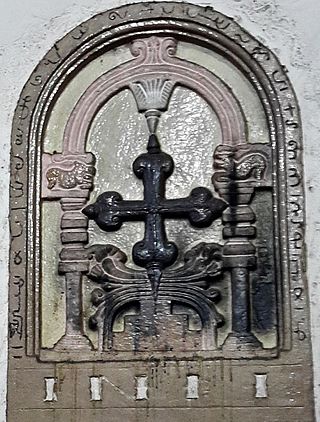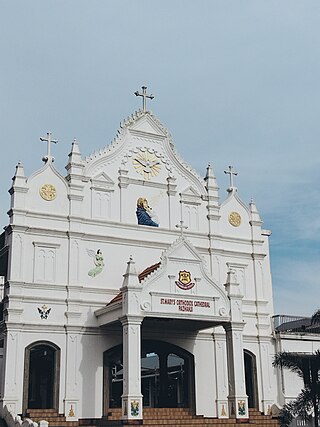
The Malankara Orthodox Syrian Church (MOSC) also known as the Indian Orthodox Church (IOC) or simply as the Malankara Church, is an autocephalous Oriental Orthodox Church headquartered in Devalokam, near Kottayam, India. It serves India's Saint Thomas Christian population. According to tradition, these communities originated in the missions of Thomas the Apostle in the 1st century. It employs the Malankara Rite, an Indian form of the West Syriac liturgical rite.

The Malankara Metropolitan or the Metropolitan of Malabar is an ecclesiastical title given to the head of the Malankara Syrian Church. It evolved from the title of the sixteenth century East Syriac metropolitans of India who were also styled the Metropolitan of Malabar. Since the division among the Saint Thomas Christians following the Synod of Diamper, the title has been mostly employed in association with the West Syriac branch of the community, usually known as the Malankara Church, among whom the office of the Malankara Metropolitan became the continuation of the local dynastic Archdeaconate.
Dionysius IV (born Cheppad Peelipose, was 12th Malankara Metropolitan from 27 August 1825, until he abdicated in 1852 and 107th Successor to the Holy Apostolic Throne of St.Thomas.
Mar Thoma V was the 5th Malankara Metropolitan who served puthenkoor from 1728 to 8 May 1765. He was born as Ousep to the Pallippuram branch of the Pakalomattom family, situated in Andoor, Marangattupilly, where his father served as administration chief of Vadakkumkur Kings. He was ordained in 1728 and served as Malankara Metropolitan for 37 years until his death on May 8, 1765. His final resting place is Niranam St. Mary’s Church. His tenure faced numerous challenges and conflicts with bishops sent from the Syriac Orthodox Patriarchate in Antioch, resulting in some of these Syriac bishops being banished from the country and forced to return.

This article lists the various old and ancient churches that exist among the Saint Thomas Christians in Kerala.
Mar Thoma VIII was the 8th Metropolitan of the Malankara Church in Kerala, India from 1809 to 1816. He was a man of vision. It was during his time Malankara church opened the first formal educational institution, in Kerala. With the opening of Kottayam Suryani Seminary, modern education dawned in Kerala.
Mar Dionysius II, born Pulikkottil Joseph Ittoop was 10th Malankara Metropolitan for nine months until his death on 24 November 1816. He dethroned Mar Thoma IX and succeeded him by the favour of Col.John Munroe, then British Resident of Travancore. Despite the brevity of his reign he made lasting contributions to the Malankara Orthodox Syrian Church.

The Jacobite Syrian Christian Church, or the Syriac Orthodox Church in India, is a Maphrianate of the Syriac Orthodox Church of Antioch based in Kerala, India and part of the Oriental Orthodox Church. It recognizes the Syriac Orthodox patriarch of Antioch and All the East as supreme head of the church. It functions autonomously within the church as an Archdiocese, administered by the Metropolitan Trustee, under the authority of the Maphrian of India, Baselios Thomas I. Following schism with the Malankara Orthodox Syrian Church, it is currently the only church in Malankara that is under the administrative supervision of Syriac Orthodox Church. The church employs the West Syriac Rite Liturgy of Saint James.

Kannamcode Cathedral or Kannamcode St. Thomas Orthodox Cathedral is one of the oldest churches in Central Travancore. The church belongs to the Malankara Orthodox Syrian Church under 'Adoor-Kadampanad' diocese. Kannamcode Cathedral is situated in Adoor, a town in Pathanamthitta district of the Indian state of Kerala. Adoor has a large population of Syrian Christians. Christianity in this locality has a tradition of more than a millennium and a half years, beginning from the village of Kadampanad. St. Thomas Orthodox Cathedral, Kannamcode, a very old Church in central Travancore, has a history of approximately 900 years, belonging to the Malankara Orthodox Syrian Church under 'Adoor-Kadampanad' diocese. Kannamcode. At Kadampanad the age of early Christian community dates back to 4th century A.D about two centuries later than the arrival of St. Thomas on the Kerala coast. Prior to the building of this church, the Christian community had to depend on near-by churches - Thumpamon Orthodox Church and third Kannamcode Cathedral to full fill their Christian services and spiritual needs. The people had to walk quite a bit of distance to attend church services and return to their village and it appeared to be tedious. Upon getting necessary permission and support from the local Hindu kings of Kayankulam, at last, a church came into being then called Veerappallil Yakoba Palli", later renamed as Kannamcode St. Thomas Orthodox Church. The same church is presently known as Kannamcode St. Thomas Orthodox Cathedral.
Mar Thoma IV was the 4th Malankara Metropolitan of the Malankara Church in India, serving from 1688–1728. During his tenure, the church was subject to a number of persecutions.

The Malankara Church, also known as Puthenkur, is the historic unified body of West Syriac Saint Thomas Christian denominations which claim ultimate origins from the missions of Thomas the Apostle. This community, under the leadership of Thoma I, opposed the Padroado Jesuits as well as the Propaganda Carmelites of the Latin Church, following the historical Coonan Cross Oath of 1653. The Malankara Church's divisions and branchings have resulted in present-day Churches that include the Jacobite Syrian Christian Church, the Malankara Orthodox Syrian Church, the Malankara Mar Thoma Syrian Church, the Malabar Independent Syrian Church, the Syro-Malankara Catholic Church, the Saint Thomas Anglicans of the Church of South India and the St. Thomas Evangelical Church of India.
Baselios Sakralla III of Aleppo was the Maphriyano (Catholicos) of the Syriac Orthodox Church of the East from 1748 to 1760. Maphriyano Sakralla came to India in 1751 and was buried at Marth Mariam Cathedral Kandanad in 1764 AD.

Karthikappally is a village in Alappuzha district in the Indian state of Kerala.Haripad is the headquarter of Karthikappally Taluk. Taluk office is located at revenue tower Haripad.
Pazhanji is a village with near Kunnamkulam in Thrissur district in the state of Kerala, India. The name "Pazhanji" is derived from the Malayalam word for "old".
St. Thomas Marthoma Church, also called as Kozhencherry Valiya Palli is a prominent Christian church under the Malankara Mar Thoma Syrian Church, located in the heart of Kozhencherry town on the banks of River Pamba in Pathanamthitta district of Central Travancore region of Kerala, India. The Maramon Convention, the largest Christian gathering in Asia, is held in every February on the sand bed of Pamba which is near to the church. This is one of the oldest churches in Kerala, established in AD 1599. In 1941 the new church was built adjacent to the old church. At the time of construction of the new church, this was the biggest Christian church building in the Central Travancore region.
Kandanad West Diocese is one of the 30 dioceses of Malankara Orthodox Syrian Church

Kandanad Valiyapally aka St. Mary's Orthodox Cathedral, Kandanad is a cathedral in the Kandanad village of Ernakulam District of Kerala. Believed to have been originally constructed circa 4th century AD, it has been administered by Diocese of Kandanad of the Malankara Orthodox Syrian Church. From 1974 to 2019, the Jacobite Syrian Orthodox Church administered the cathedral.

Several historical evidences shed light on a significant Malankara–Persian ecclesiastical relationship that spanned centuries. While an ecclesiastical relationship existed between the Saint Thomas Christians of India and the Church in Sassanid Empire in the earlier centuries, closer ecclesiastical ties developed as early as seventh century, when India became an ecclesiastical province of the Church of the East, albeit restricted to matters of purely ecclesiastical nature such as ordination of priests, and not involved in matters of temporal administration. This relationship endured until the Portuguese protectorate of Cochin of Malabar came to be in 16th century, and the Portuguese discovery of a sea route to India. The Christians who came under the two ancient yet distinct lineages of Malankara and Persia had one factor in common: their Saint Thomas heritage. The Church of the East shared communion with the Great Church until the Council of Ephesus in the 5th century, separating primarily over differences in Christology.

St. Thomas Orthodox Cathedral, Kadampanad, popularly known as Kadampanad Church is an ancient church of Saint Thomas Christians situated in the Central Travancore village of Kadampanad, in Pathanamthitta District, Kerala, India. This Church belongs to the Malankara Orthodox Syrian Church under the Diocese of Adoor-Kadampanad.

Pazhanji Church, officially known as St. Mary's Orthodox Cathedral, Pazhanji or Pazhanji Cathedral, is a Malankara Orthodox Syrian Church situated at Pazhanji near Kunnamkulam in Thrissur District of Kerala, India. The Church is locally called " Pazhanji Palli " "Palli" [similar to the Malayalam word for "Church"].









